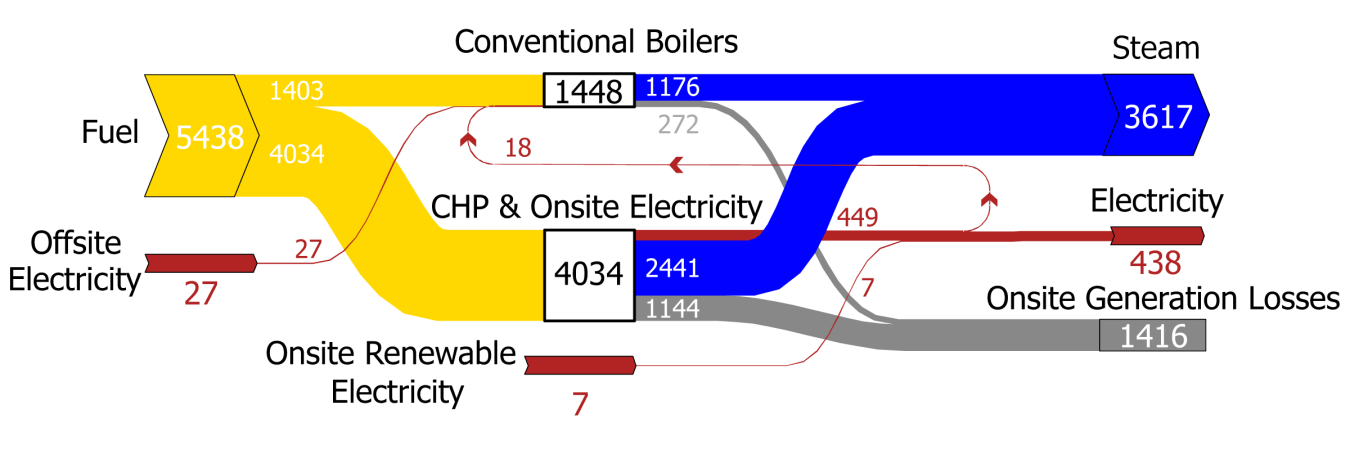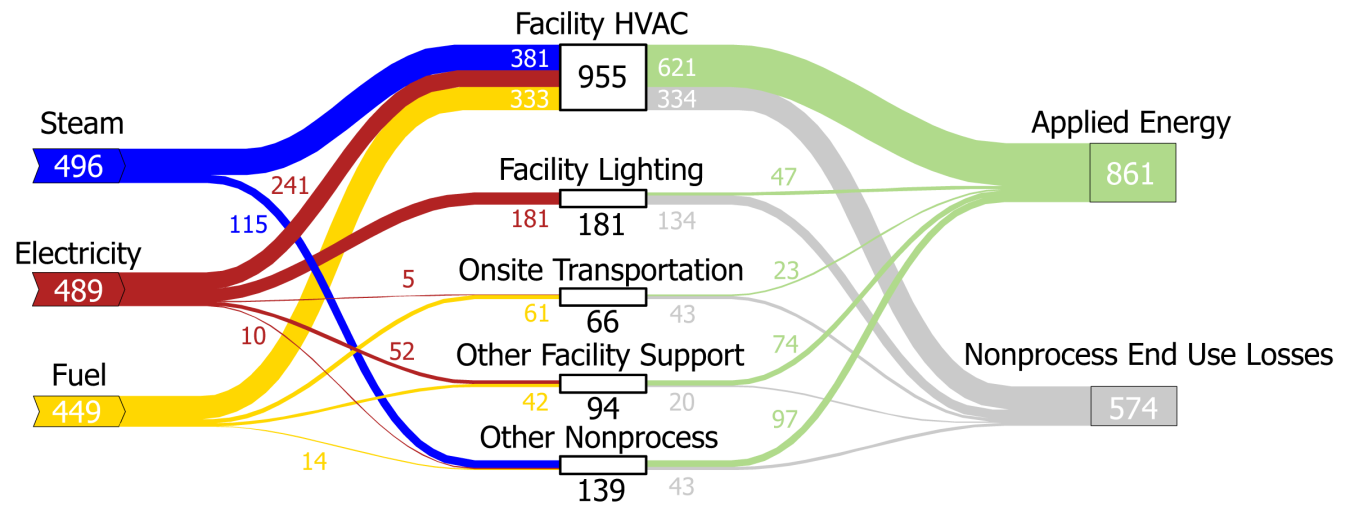Note: The Static Sankey diagrams were updated in May 2019 (available here) with the latest U.S. Energy Information Administration (EIA) Manufacturing Energy Consumption Survey (MECS) data for 2014 and updated assumptions.
The U.S. Manufacturing Sector Static Sankey diagram shows how total primary energy is used by U.S. manufacturing plants, based on EIA MECS data for 2010.
Click on the Onsite Generation, Process Energy or Nonprocess Energy thumbnails below the diagram to see further detail on energy flows in manufacturing. Also, see the Dynamic Manufacturing Energy Sankey Tool to pan, zoom, and customize the manufacturing Sankey data and compare energy consumption across manufacturing subsectors.
The U.S. Manufacturing sector Sankey diagram below shows the fuel, steam, and electricity entering U.S. manufacturing plants from offsite sources. Renewable electricity generated onsite is also shown. A large portion of the primary energy is lost during the offsite generation and subsequent transmission of steam and electricity to the manufacturing facilities (e.g., electric grid losses). Further losses occur when a portion of the fuel is transformed into steam and electricity at the facilities, and there are additional losses associated with onsite steam distribution. The fuel, steam, and electricity from offsite and onsite sources are used either directly in production (process energy) or in supporting functions (non-process energy). Applied energy (applied toward direct production or end use at the plant) is determined by subtracting the offsite generation and transmission losses, onsite generation and distribution losses, and end use losses.
These diagrams visually complement the 2010 MECS data Manufacturing Energy and Carbon Footprint analysis. Definitions of terms used in this Sankey diagram are at the bottom of this page.
TERMINOLOGY
Applied Energy: Amount of total primary energy employed in direct end use.
End Use Losses: System and equipment losses that occur in process and nonprocess energy end use (e.g., electric motor shaft losses, or process heating insulation and exhaust losses).
Energy Losses: The sum of offsite electricity and steam generation and transmission losses, onsite generation and distribution losses, and direct end use losses.
Nonprocess Energy: Energy used for purposes other than converting raw material into manufactured product. MECS-specified categories of nonprocess energy include facility heating, ventilation, and air conditioning (HVAC), facility lighting, onsite transportation, other facility support (e.g., cooking, water heating, office equipment), and other nonprocess use.
Offsite Electricity Generation (net): The sum of purchased electricity and electricity transfers into the plant boundary less quantities sold and transferred out.
Offsite Generation and Transmission Losses: The sum of energy losses incurred during the generation and transport of steam and electricity to the plant boundary.
Offsite Steam Generation (net): The sum of steam transfers and purchased steam from the local utility or other sources, less quantities sold and transferred out.
Onsite Generation: The generation of steam or electricity within the plant boundaries using fuel or electricity. Onsite generation includes three categories: “conventional boilers” (to produce steam), “CHP/cogeneration” (to produce steam and electricity), and “other electricity generation” (consisting of onsite electricity obtained from generators running on combustible energy sources including natural gas, fuel oils, and coal and electricity generated onsite from renewable sources other than biomass (e.g., solar, wind, hydropower, and geothermal)).
Onsite Generation and Distribution Losses: The sum of energy losses incurred during the generation of steam and electricity within plant boundaries.
Onsite Renewable Electricity Generation: Electricity generated onsite from renewable sources other than biomass (e.g., solar, wind, hydropower, and geothermal).
Process Energy: Energy used in industry-specific processes, such as chemical reactors, steel furnaces, glass melters, casting, concentrators, distillation columns, etc. MECS-specified categories of process energy include process heating (e.g., kilns, ovens, furnaces, strip heaters), process cooling and refrigeration, machine drive (e.g., motors, pumps associated with process equipment), electro-chemical processes (e.g., reduction process), and other direct process uses.
NOTES
- The data source for this Sankey Diagram is the 2010 MECS data Manufacturing Energy and Carbon Footprint. The footprint analysis utilizes 2010 EIA Manufacturing Energy Consumption Survey (MECS) data, with adjustments, to quantify steam generation, electricity generation, and incoming fuel; onsite steam and electricity generation; and end use of electricity and fuel. Steam end use is not provided by MECS but rather is dependent on analysis alone.
- Energy values represent aggregate sector-wide data for 2010 in TBtu/yr, rounded to nearest whole number
- Excludes feedstock energy (byproduct fuels from feedstock are included)
- Arrow and box heights are proportional to flow size except for small flows for visual convenience
- Energy losses do not equate to recoverable energy, as a portion of these losses are thermodynamically unrecoverable
- Offsite generation shown on net basis (purchases, sales, and transfers accounted for)





